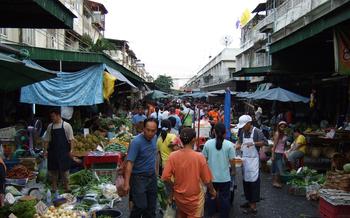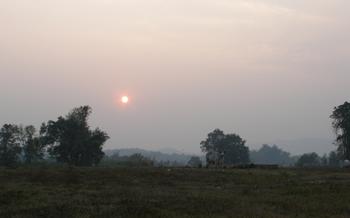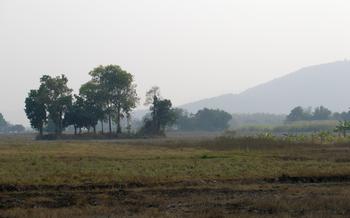
Pha Suea Waterfall
- Pha Suea Waterfall: An Overview
- Exploring the Waterfall
- The Cave Adventure
- Local Culture and Traditions
- Festivals and Events
- Photography Opportunities
- Wildlife Spotting
- Accommodation Options
- Food and Dining
- Getting There
- Best Time to Visit
- Budget Considerations
- Health and Safety
- Insider Tip: Unveiling Hidden Gems and Authentic Experiences
Pha Suea Waterfall: An Overview
At the heart of Mae Hong Son, Thailand, lies the majestic Pha Suea Waterfall, a testament to nature's grandeur. Its name, meaning "Tiger Waterfall," originates from a legend where a tiger was believed to have been washed away by the waterfall's powerful currents. With a history shrouded in mystery and folklore, Pha Suea has become a significant landmark in the region, attracting both locals and tourists with its breathtaking beauty.
Nestled in the lush forests of Mae Hong Son, the waterfall is easily accessible by road from the city center. As you approach, the sound of cascading water fills the air, creating a sense of tranquility that envelops the entire area. The surrounding landscape is a tapestry of verdant hills, blooming wildflowers, and towering trees, providing a picturesque backdrop to the waterfall's stunning display.
Exploring the Waterfall
The Pha Suea Waterfall consists of multiple levels, each offering unique perspectives and experiences. From the base of the falls, visitors can marvel at the cascading waters and the mist that envelops the surroundings. Ascend the stone steps carved into the hillside, and you'll encounter various viewpoints that provide breathtaking panoramas of the waterfall and the lush jungle backdrop.
For those seeking a more immersive experience, hiking trails and paths lead to the upper levels of the falls. These trails offer challenges for outdoor enthusiasts while rewarding them with secluded spots and hidden cascades. Along the way, you'll encounter diverse flora and fauna, including exotic orchids and colorful butterflies.
For the adventurous, swimming and wading in the refreshing pools at the base of the waterfall are exhilarating experiences. The cool waters provide a respite from the tropical heat and offer a unique perspective of the falls from below. However, caution is advised, as the currents can be strong, especially during the rainy season.
The Cave Adventure
Behind the cascading Pha Suea Waterfall lies a hidden gem waiting to be explored – the Tham Pha Suea cave. This natural wonder invites adventurous souls to embark on a captivating journey through its mysterious depths. As you venture into the cave, you'll be greeted by a series of chambers adorned with mesmerizing stalactite and stalagmite formations. The intricate patterns and shapes created by these rock formations will leave you in awe of nature's artistry.
The cave's history is intertwined with archaeological discoveries that shed light on the region's past. Ancient artifacts and remnants of human habitation have been found within the cave, providing valuable insights into the lives of the people who once called this place home. Exploring Tham Pha Suea cave is more than just a physical adventure; it's a journey through time that connects you with the history and culture of this captivating region.
For those seeking a truly immersive experience, guided tours are available to lead you through the cave's intricate passageways and provide fascinating commentary on its geological and historical significance. Whether you choose to explore independently or with a guide, the Tham Pha Suea cave promises an unforgettable adventure that will leave you with lasting memories.
Local Culture and Traditions
Enrich your visit to the Pha Suea Waterfall by immersing yourself in the vibrant culture of the Karen people, an ethnic minority group native to this region. A short walk from the waterfall will bring you to their village, where you can witness their unique way of life.
Visiting the Karen Village
The Karen people are known for their strong community spirit and their deep connection to nature. As you enter their village, you will be greeted with warm smiles and welcoming gestures. Take the opportunity to explore their traditional houses, built using bamboo and wood, and adorned with intricate carvings. Observe their daily activities, such as weaving colorful textiles, farming, and tending to their livestock.
Learning about Their Unique Customs and Lifestyle
The Karen people have a rich cultural heritage, and they are eager to share their customs and traditions with visitors. Engage in conversations with the villagers to learn about their beliefs, their language, and their fascinating history. They may even invite you to join them for a traditional meal or a cup of their locally grown tea.
Handicraft Workshops and Traditional Performances
The Karen people are skilled artisans, and they excel in creating beautiful handicrafts using natural materials like bamboo, wood, and cotton. Visit their workshops to observe their intricate weaving techniques and purchase unique souvenirs to take home. In the evenings, enjoy traditional Karen performances that showcase their music, dance, and storytelling. These performances offer a glimpse into their vibrant culture and provide a memorable conclusion to your visit to the Pha Suea Waterfall.
Festivals and Events
The Pha Suea Waterfall Festival is an annual event that celebrates the beauty and significance of the waterfall. Held in November or December, the festival attracts both locals and tourists who come to experience the vibrant cultural heritage of the region.
During the festival, the waterfall is adorned with colorful lights and decorations, creating a magical atmosphere. Visitors can enjoy a variety of activities, including traditional Thai dance performances, music shows, and food stalls offering a range of local delicacies.
One of the highlights of the festival is the "bathing of the Buddha" ceremony, where a sacred Buddha image is carried in a procession to the waterfall and bathed in its waters. This ritual is believed to bring good luck and prosperity to the community.
The Pha Suea Waterfall Festival is a wonderful opportunity to immerse oneself in the rich culture and traditions of Mae Hong Son. Visitors can learn about local customs, enjoy traditional performances, and savor the delicious flavors of Thai cuisine, all while celebrating the natural beauty of one of the region's most iconic landmarks.
Photography Opportunities
The Pha Suea Waterfall presents a photographer's paradise, with its cascading waters, lush greenery, and scenic surroundings. Capturing the beauty of this natural wonder requires an eye for composition and a keen understanding of lighting conditions.
For the best shots, visit the waterfall during the early morning or late afternoon when the sun's rays create a golden glow that illuminates the falls. Experiment with different angles to capture the full grandeur of the waterfall, from wide-angle shots that showcase the entire cascade to close-ups that highlight the intricate details of the water's flow.
Several popular photography spots offer unique perspectives of the waterfall. The viewing platform at the base of the falls provides a classic vantage point for capturing the full height and power of the cascade. For a more intimate view, venture onto the wooden walkways that lead closer to the falls, allowing you to capture the water's intricate textures and patterns.
Don't forget to explore the surrounding area for additional photo opportunities. The lush forest that envelops the waterfall is home to a variety of flora and fauna, providing ample subjects for macro photography and wildlife shots. With a bit of patience and observation, you might capture a fleeting moment of a bird in flight or a shy animal peeking out from the undergrowth.
Wildlife Spotting
The Pha Suea Waterfall area is not only a natural wonder but also a haven for wildlife enthusiasts. The diverse ecosystem surrounding the waterfall is home to a remarkable range of animal species. Birdwatching enthusiasts will be delighted by the colorful variety of birds that call this region their home. From vibrant kingfishers and sunbirds to majestic eagles soaring overhead, there's an abundance of avian life to observe.
Venturing along the hiking trails, visitors may encounter other wildlife inhabitants, such as playful squirrels, shy lizards, and perhaps even the rare sight of a barking deer or a wild boar. The rustling of leaves might reveal a glimpse of a monitor lizard or a snake slithering through the undergrowth. While encountering larger animals is uncommon, the opportunity to spot these creatures in their natural habitat adds an element of excitement to the exploration.
Accommodation Options
Pha Suea Waterfall offers a range of accommodation options for visitors, catering to different budgets and preferences.
-
Guesthouses: Several guesthouses are located near the waterfall, offering basic but comfortable rooms with essential amenities. Prices typically start from 300 baht per night.
-
Homestays: For a more immersive experience, you can opt for a homestay in a nearby Karen village. Homestays provide a chance to learn about the local culture and lifestyle while enjoying home-cooked meals. Prices range from 500 to 1,000 baht per night, including meals.
-
Booking Recommendations: To secure your accommodation, it's advisable to book in advance, especially during peak season. Online platforms like Booking.com and Airbnb offer a wide selection of guesthouses and homestays.
-
Amenities and Facilities: Most guesthouses and homestays provide basic amenities such as Wi-Fi, hot water, and laundry services. Some guesthouses may also have a restaurant or a tour desk.
Food and Dining
When visiting Pha Suea Waterfall, indulging in the local culinary delights is a must. From traditional Thai cuisine to street food options, there's something to satisfy every palate.
Local Restaurants and Eateries:
- Mae Hong Son Town:
- Khao Soi Mae Sai: Savor the famous Northern Thai dish of khao soi, a rich coconut curry noodle soup, at this popular eatery.
-
Huen Phen: Experience authentic Lanna cuisine in a traditional wooden house setting, known for its gaeng hang lay, a spicy pork belly curry.
-
Pai:
- Walking Street: Explore the vibrant Pai Walking Street, lined with food stalls offering a variety of Thai and international dishes.
- Pai Night Market: Indulge in delicious street food options, from grilled meats to fresh seafood, at the lively Pai Night Market.
Trying Traditional Thai Cuisine:
- Khao Neeo Mamuang: Don't miss the classic Thai dessert of sweet sticky rice with ripe mangoes, a perfect treat to cool down after a day of exploring.
- Sai Oua: Sample the local specialty of sai oua, a flavorful Northern Thai sausage made with minced pork, herbs, and spices.
- Tom Kha Gai: Warm up with a bowl of tom kha gai, a coconut milk-based soup with chicken, galangal, and lemongrass.
Street Food Options:
- Pad Thai: Enjoy the ubiquitous Thai dish of pad thai, stir-fried rice noodles with vegetables, eggs, and your choice of protein.
- Som Tum: Try som tum, a spicy green papaya salad, a refreshing and tangy dish that's a staple of Thai cuisine.
- Khao Pad: Indulge in khao pad, fried rice with your choice of ingredients, a quick and easy meal that's a favorite among locals.
Getting There
Reaching Mae Hong Son, where the Pha Suea Waterfall is located, involves a scenic journey through northern Thailand. Transportation options vary depending on your starting point and budget.
By Air: - The nearest airport is Mae Hong Son Airport (HGN), with limited flights from Bangkok and Chiang Mai. From the airport, you can take a taxi or hire a car to reach your accommodation.
By Bus: - Regular buses operate from various cities in Thailand, including Bangkok, Chiang Mai, and Pai. The journey takes approximately 8-10 hours, offering a chance to enjoy the countryside views.
By Train: - Mae Hong Son is not directly connected by rail. However, you can take a train to Chiang Mai and then transfer to a bus or minivan for the remaining journey.
Renting a Car or Motorbike: - For a more adventurous experience, consider renting a car or motorbike in Chiang Mai or Pai. The roads are generally well-maintained, and the scenery along the way is breathtaking.
Joining a Guided Tour: - If you prefer a hassle-free experience, several tour operators offer guided trips to Mae Hong Son from Chiang Mai or Bangkok. These tours typically include transportation, accommodation, and activities.
Best Time to Visit
Timing your visit to Pha Suea Waterfall is crucial for an enjoyable experience. The best time to visit is during the dry season, typically from November to April. During this time, the weather is pleasant, with clear skies and minimal rainfall, allowing you to fully appreciate the waterfall's beauty without the hindrance of heavy rains.
The rainy season, from May to October, brings abundant rainfall, transforming the landscape into a lush green paradise. While the falls are still accessible during this time, the increased water flow can make swimming and wading challenging, and the trails might become slippery.
The peak tourist season, which coincides with the cool and dry months from December to February, attracts a larger crowd, so be prepared for more visitors. If you prefer a quieter experience, consider visiting during the shoulder months of November and April, when the weather is still favorable, but the crowds are smaller.
Remember, the weather in Thailand can be unpredictable, so it's always a good idea to check the local forecast before finalizing your travel plans.
Budget Considerations
Visiting Pha Suea Waterfall and the surrounding area can be budget-friendly with careful planning. Entrance fees to the waterfall are minimal, and there are no additional charges for hiking or swimming. Consider staying in guesthouses or homestays, which offer affordable accommodation options. Dining at local restaurants and trying street food can be more economical than opting for tourist-oriented establishments.
Transportation costs can be reduced by renting a motorbike or joining a guided tour. Renting a motorbike offers the freedom to explore at your own pace and can be a cost-effective option for solo travelers or small groups. Joining a guided tour can be beneficial for those who prefer a hassle-free experience and want to learn more about the area's history and culture.
To save on souvenirs and handicrafts, visit local markets and compare prices before making purchases. Bargaining is acceptable, so don't hesitate to negotiate for a better deal. Remember, being mindful of your budget doesn't mean compromising on experiences. With a little planning, you can enjoy the beauty of Pha Suea Waterfall and its surroundings without breaking the bank.
Health and Safety
When visiting Pha Suea Waterfall, it's crucial to prioritize your well-being. Wear comfortable clothing and sturdy footwear suitable for trekking and exploring the cave. The humidity and heat can be intense, so staying hydrated is essential. Bring a water bottle and replenish it regularly. Sun protection is also vital; apply sunscreen and consider wearing a hat to shield yourself from the sun's rays.
Regarding safety, always be cautious and aware of your surroundings. The paths can be slippery, so tread carefully. Be mindful of the water's depth and currents when swimming or wading. If you're exploring the cave, carry a flashlight or headlamp to illuminate the dark corners. Additionally, inform someone about your plans and expected return time for added safety.
Insider Tip: Unveiling Hidden Gems and Authentic Experiences
Beyond the main attractions, Mae Hong Son offers hidden gems and authentic experiences that await the curious traveler. Venture off the beaten path to discover secluded viewpoints that offer breathtaking panoramas of the waterfall and surrounding landscape. These spots are perfect for capturing stunning photographs and enjoying a serene moment away from the crowds.
Engage with the friendly locals to gain insights into their unique way of life. Visit the nearby Karen village, where you can learn about their customs, traditions, and craftsmanship. Participate in hands-on workshops to create your own handmade souvenirs, or witness traditional performances that showcase their rich cultural heritage.
For a truly immersive experience, consider staying at a local guesthouse or homestay. This is a wonderful opportunity to connect with the community, savor home-cooked meals, and gain a deeper understanding of the local lifestyle. Embrace the simplicity and warmth of Thai hospitality as you immerse yourself in the vibrant culture of Mae Hong Son.




